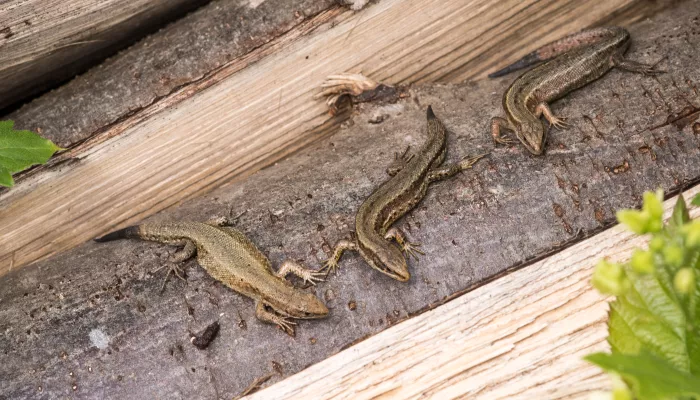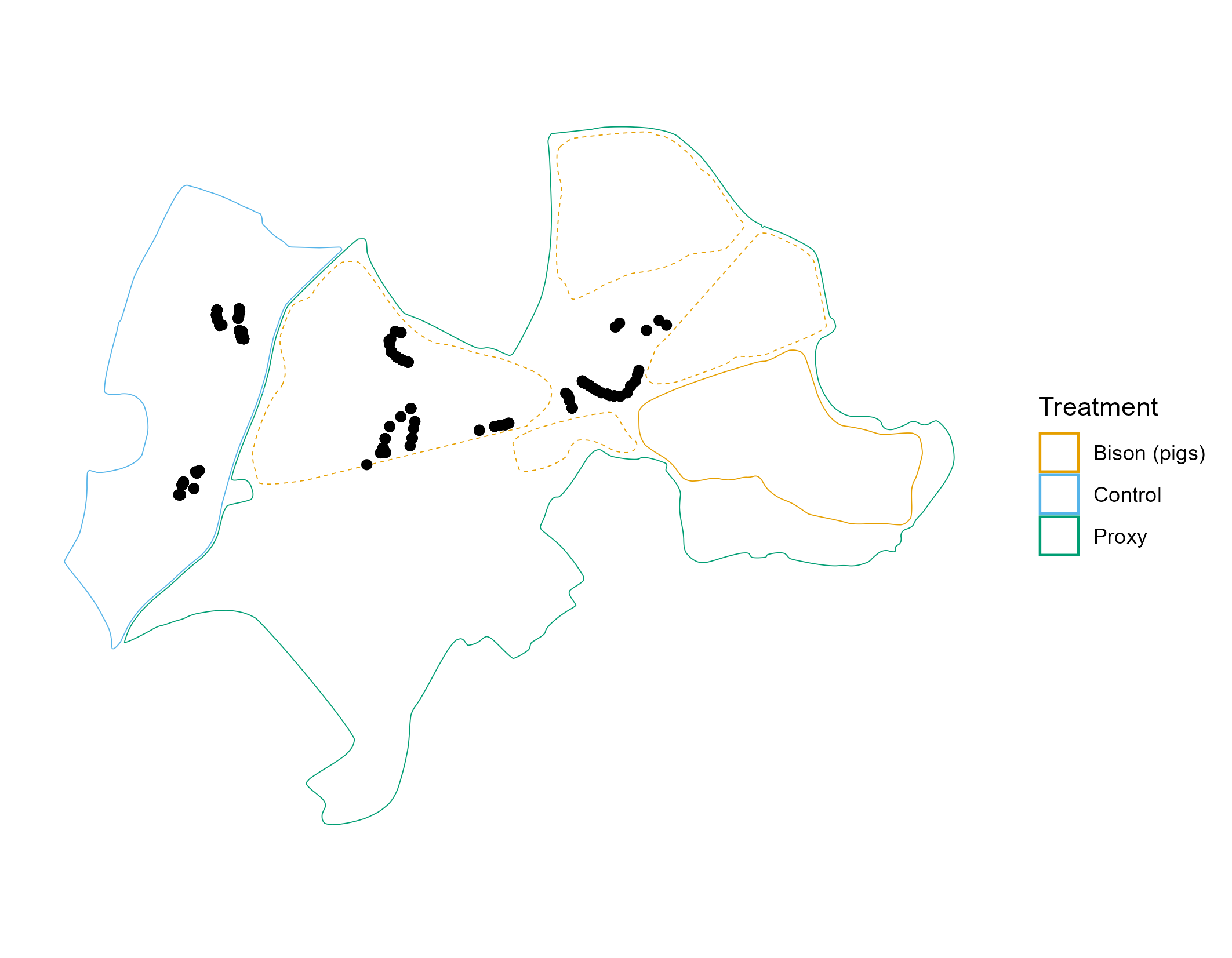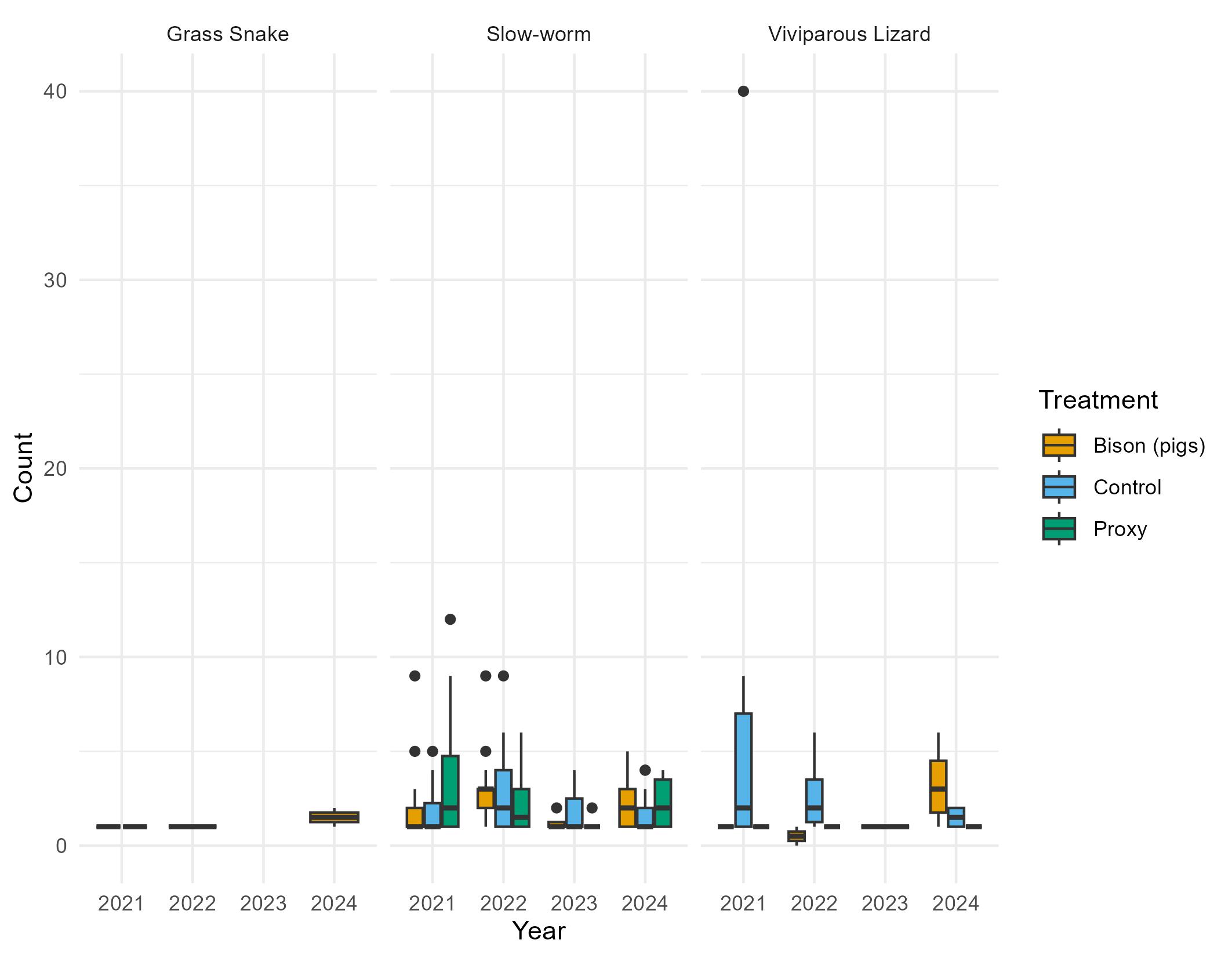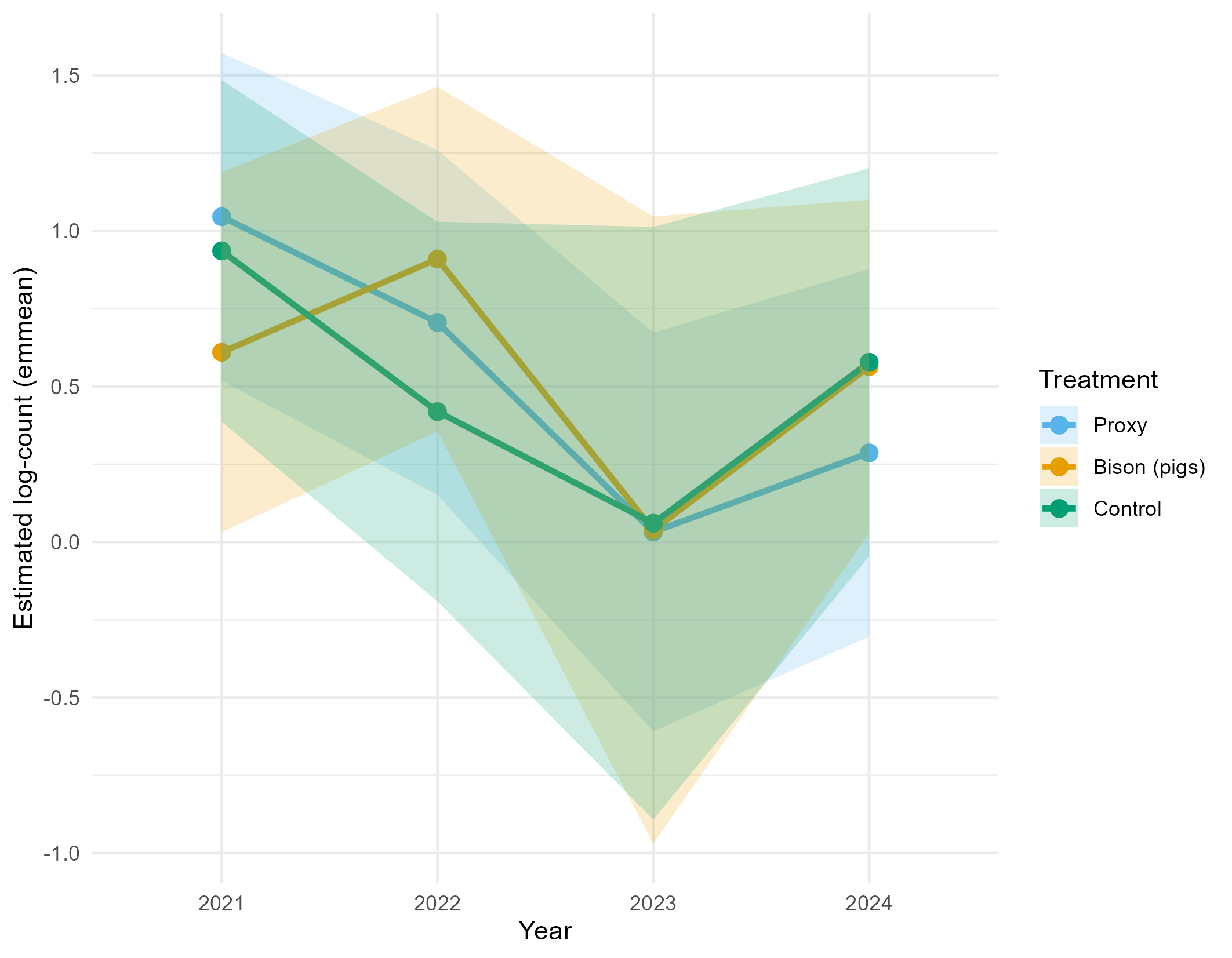Background
Wilder Blean is a wilding project at West Blean and Thornden Woods, near Canterbury, Kent, UK. The surrounding Blean woodland complex is one of the largest surviving blocks of ancient semi-natural woodland in England. Wilder Blean currently covers an area of 562 hectares, comprising a mosaic of ancient oak-hornbeam woodland, mixed broad-leaved coppice with standards, extensive stands of sweet chestnut coppice, conifer plantations, and small areas of heath, wetlands as well as several man-made ponds.
Large grazing herbivores, including European Bison Bison bonasus, Exmoor Ponies Equus ferus caballus, British Longhorn Cattle Bos primigenius, and Ironage Pigs Sus scrofa × Sus domesticus, were introduced at Wilder Blean in 2022. This is a trial with the aim of improving the condition of the nationally important Site of Special Scientific Interest, some of which is in unfavourable condition (Natural England, 2025).
Large grazing herbivores went extinct in the UK, and across much of Europe during the late Holocene at the end of the last Ice Age, due to a combination of human activity and environmental changes. This was detrimental to the ecosystems in which they evolved, as the functions they provided were lost and natural processes they facilitated were disrupted. Large herbivores control plant growth, maintaining habitat mosaics which support more species, and they disperse seeds that they consume. They create microhabitats by disturbing the ground through trampling, dust bathing or wallowing. They recycle nutrients from plants back into the soils through their dung. They are prey for large predators and scavengers, and support birds and invertebrates that use them as hosts, their dung for food, or their fur for nesting materials. They sequester carbon into soils through their dung and by encouraging new rapid plant growth (Borer and Risch, 2024).
At Wilder Blean, the large herbivores have been reintroduced, but their dispersal is limited by fences, a requirement of government policy. The fences are arranged to provide a robust experimental design, comprising three different treatments. The ‘Bison treatment’ contains European Bison only. The ‘Conservation Grazers treatment’ contains conventional conservation livestock including Longhorn Cattle, Exmoor Ponies and Iron-age pigs. The ‘Control treatment’ contains no introduced grazing animals and is managed by a human workforce, including coppicing, for example.
However, due to the delayed construction of the bison tunnels, which allow the animals to travel under public rights of way and disperse across the site, the bison treatment has been limited to only one of five parcels in the southeast of the site, where reptilee monitoring was not conducted. Iron-age pigs have been present in the northwest compartment, where reptile monitoring has taken place, in addition to the control and proxy areas. Therefore, this report summarises the results of the reptile surveys conducted between 2021 and 2024, which provide an overall picture of the local reptile community and provides some insights into the effects of Iron-age pigs and the other livestock breeds in the proxy treatment.
Methodology
Reptile counts were assessed across the three treatments (pigs, control and proxy). Bison were not present in the compartment where the refugia were placed to sample the effects of bison. Instead, Iron-age pigs have been present in this compartment over the study period. Sampling was conducted at multiple fixed refugia within each treatment, though the number of refugia varied between treatments. Each refugium was checked three times per year over a four-year period (2021-2024). Most refugia were corrugated tin sheets (Onduline) (n=358) while some were roofing felt (n=27). Environmental variables, including air temperature, cloud cover, wind speed, precipitation, wind direction, and ground conditions, were measured at each refugium during every survey.
Reptile counts from each refugium were aggregated to represent the total number of individuals of each species found per refugium per year. In three locations, no reptiles were found in a given year but were included in the analysis as zero counts.
A Generalized Linear Mixed Model (GLMM) was used to model the count of reptile individuals. This model was fitted using a Poisson distribution, which is suitable for over-dispersed count data (lots of low counts). The model's fixed effects included treatment, year, and the interaction between them, as well as air temperature. Refugium ID and species were included as random effects to account for repeated measurements from the same refugia and to account for non-independence of observations within each location and species.
Results
The results showed that overall the bison (pigs) and proxy treatments were not significantly different in species count compared to the control group (bison (pigs): β^ = -0.427, p = 0.111; proxy: β^ = -0.107, p = 0.650).
Conversely, there was a significant overall decrease in species count over time, with counts in 2023 (β^ = -1.004, p < 0.001) and 2024 (β^ = -0.754, p < 0.001) being significantly lower than in the baseline year of 2021. The count in 2022 was also lower, but this effect was only marginally significant (β^ = -0.341, p = 0.051).
The interaction between treatment and year revealed that the effect of time varied across the different treatment groups. Specifically, the decline in species count observed in the overall temporal trend was much reduced in the bison group. In 2022, the interaction term between the year and bison (pigs) treatment was significant (β^ = 0.609, p = 0.043). This means counts in the bison (pigs) treatment were closer to the 2021 levels than in the control group for that year. Again, in 2024, the interaction term between the year and bison (pigs) treatment was also significant (β^ = 0.728, p = 0.026). This large positive effect negated the significant main temporal trend in counts. The combined effect resulted in a near-zero change in count for the bison (pigs) treatment in 2024 (β^ = -0.027). The decline was halted in the bison (pigs) area in 2024. No other interaction terms were statistically significant, suggesting that the counts in the proxy and control treatments followed a similar decline over time.
Air temperature had a significant positive relationship with species count (β^ = 0.051, p = 0.039). For every one-unit increase in air temperature, the species count was estimated to increase by approximately 5.2%.
Both random effects were important components of the model, indicating significant variation in counts that was not explained by the fixed effects. The standard deviation of the intercept for refugium ID was 0.527, and 0.553 for species. This indicates that there were notable differences in baseline abundance between different sample locations and between different species.
Discussion
This analysis aimed to understand the effects of treatment and annual variation on reptile species abundance, while accounting for natural variability across sampling locations and species. Our findings reveal an interplay between temporal trends and treatment effects, with the most notable result being the lack of a decline in species counts in the bison (pigs) treatment.
The model revealed a decrease in overall species count from 2021 to 2024. The hot and dry climate in recent years, especially the record highs in 2022, have affected other wildlife communities in Wilder Blean and across the Southeast of England. Reptiles, being ectotherms, are particularly sensitive to changes in seasonal or microclimatic conditions, as highlighted by the observed relationship between species count and air temperature that persisted across all treatments and years.
Across all years, the main effects of the bison (pigs) and proxy treatments were not statistically significant. However, our results show that the negative temporal trend observed in the control sites was largely absent in the bison (pigs) treatment. This suggests that the presence of Iron-age pigs may have created conditions that buffered the ecosystem from the factors causing the overall decline. Potential mechanisms for this could include selective grazing, trampling and rootling, which alter vegetation and soil structure, increase habitat heterogeneity, or create disturbed patches that benefit certain species. Furthermore, presence of large herbivores like pigs increases invertebrate populations, which are a prey source for reptiles.
It is important to acknowledge the limitations of this study. The heavily overlapping confidence intervals demonstrate that while the trajectories of the treatments were different, the count values at any single time point were not statistically distinguishable. This underscores that the effect of the bison (pigs) treatment, while significant, is subtle and manifests as a long-term trend rather than an immediate, large-scale change in species count. Furthermore, the short, four-year study period is unlikely to be long enough to capture the full effects of the introduced large herbivores, and continued monitoring is required.
In conclusion, our results provide some initial evidence that the reintroduction of pigs may have a significant and positive effect on species abundance by buffering the ecosystem against broader negative environmental trends.
References
Borer E & Risch A (2024). Planning for the future: Grasslands, herbivores, and nature‐based solutions. Journal of Ecology. DOI: 10.1111/1365-2745.14323.
Natural England (accessed May 2025). West Blean and Thornden Woods SSSI. https://designatedsites.naturalengland.org.uk/SiteDetail.aspx?SiteCode=S1003346
References
Borer E & Risch A (2024). Planning for the future: Grasslands, herbivores, and nature‐based solutions. Journal of Ecology. DOI: 10.1111/1365-2745.14323.
Natural England (accessed May 2025). West Blean and Thornden Woods SSSI. https://designatedsites.naturalengland.org.uk/SiteDetail.aspx?SiteCode=S1003346




